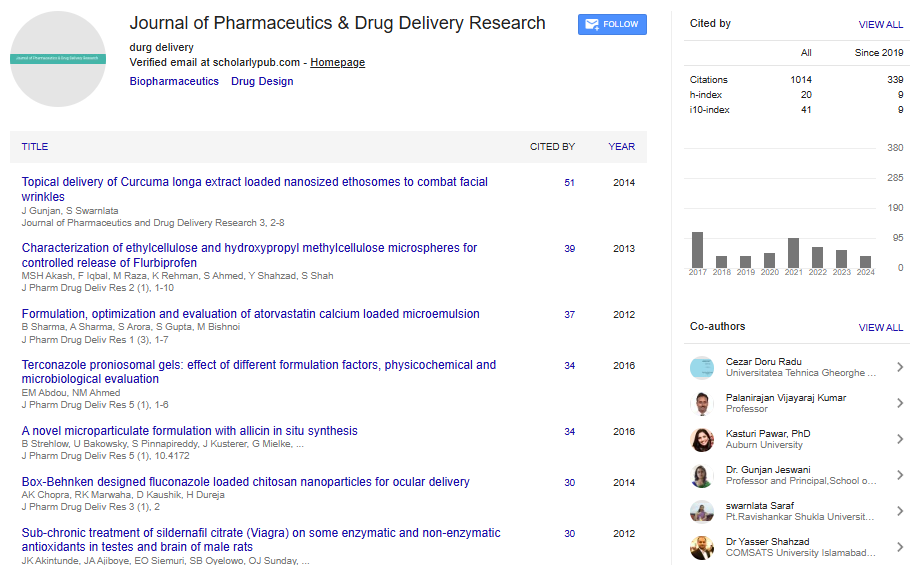Microencapsulation of vitamin B1 by spray-drying: Preparation, characterization and controlled release studies
Ioana C Carlan, Berta N Estevinho and Fernando A Rocha
University of Porto, Portugal
: J Pharm Drug Deliv Res
Abstract
Vitamin B1 represents an essential nutrient for human health, responsible for energy and metabolism. Therefore, it should be provided daily through a balanced diet. However, it is possible to develop a deficiency or diseases related to poor absorption. This usually affects persons who consume too much alcohol, pregnant women and some least developed countries. Pharmaceuticals and fortified food products with vitamin B1 microcapsules content may be a promising alternative for the prevention or treatment of deficiency. In this work, vitamin B1 was microencapsulated using spray-drying, a simple, flexible and economical technique that can overcome vitamin B1 stability problems. Several biopolymers were tested as coating materials, namely Arabic gum, carrageenan, chitosan, maltodextrin, modified chitosan, modified starch, pectin, sodium alginate and xanthan. Microcapsules with a 0.25% (w/w) of vitamin were obtained using a mini spray-dryer BÜCHI B-290 and the process showed acceptable values for the product yield: 20-50%. For the characterization of microcapsules in terms of size, a particle size analyzer was used and the morphology was determined by scanning electron microscopy. The size, shape and surface of each type of vitamin B1 microcapsules differ according to the type of biopolymer used as coating. Controlled release studies of vitamin B1 from the microcapsules were determined by spectrophotometric analysis with fresh and four months old samples, in two dissolution mediums: deionized water (20ºC) and simulated gastric fluid (37ºC). The obtained release profiles highlighted different behaviours: fast release, just a few minutes needed and slow release, up to several hours. Kinetic models, like zero order, first order, Higuchi, Korsmeyer-Peppas and Weibull were also applied to see which fits better. This research reported significant results and proved the success of microencapsulating vitamin B1 with different encapsulating agents. Also, it offered important information about the release profiles and stability over time Recent Publications 1. Edwards K A, Tu-Maung N, Cheng K, Wang B, Bauemmer A J, et al. (2017) Thiamine assays-advances, challenges and caveats (review). Chemestry Open 6(2):178-191. 2. Chatterjee N S, Anandan R, Navitha M, Asha K K, Kumar K A, et al. (2016) Development of thiamine and pyridoxine loaded ferulic acid-grafted chitosan microspheres for dietary supplementation. J Food Sci Technol. 53(1):551-560. 3. Teleki A, Hitzfeld A and Eggersdorfer M (2013) 1000 years of vitamins: the science of formulation is the key to functionality. Kona Powder and Particle Journal 30:144-163. 4. Estevinho B N, Rocha F, Santos L and Alves A (2013) Microencapsulation with chitosan by spray drying for industry applications-A review. Trends in Food Science 31:138-155. 5. Sriram K, Manzanares W and Joseph K (2012), Thiamine in nutrition therapy. Nutr Clin Pract. 27(1):41-50
Biography
Ioana C Carlan has completed both her BS (Biochemical Engineering) and MS (Pharmaceutical and Cosmetic Products) at Gheorghe Asachi Technical University of Iaci, Romania. She is currently continuing her studies with a Doctoral Program in the field of Chemical and Biological Engineering at the Faculty of Engineering from University of Porto, Portugal. Her research is focused on the microencapsulation of watersoluble vitamins using spray-drying technique. She has published two papers and has attended three conferences. carlanioana@gmail.com
 Spanish
Spanish  Chinese
Chinese  Russian
Russian  German
German  French
French  Japanese
Japanese  Portuguese
Portuguese  Hindi
Hindi 
